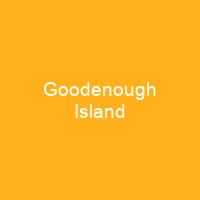Discovering the Enigma of Goodenough Island
Imagine a hidden gem in the vast Solomon Sea, where nature’s beauty and human history intertwine to create a unique tapestry. Nestled off the coast of Papua New Guinea, lies Goodenough Island, an island that has seen centuries of indigenous life, European exploration, and World War II battles. Could this be your next adventure?
The Geography of Goodenough Island
Is Goodenough Island a mere speck in the ocean or a land of its own? With an area of 687 square kilometers, it’s not just any island. Its circular shape and the towering Mount Vineuo at 2,536 meters above sea level make it a striking landscape. The shoreline stretches for 116 kilometers, offering endless opportunities for exploration.
The Climate and Vegetation
What does the climate on Goodenough Island feel like? A tropical paradise with high temperatures and humidity year-round. Rainfall varies between 1,520 mm to 2,540 mm annually, but droughts are rare. The island’s vegetation is a mix of rainforest, secondary forest, grassland, and native gardens, creating a lush environment that supports diverse wildlife.
History and Human Presence
How did humans first discover Goodenough Island? The D’Entrecasteaux Islands were likely inhabited for thousands of years by people related to mainland Papuans. The first European sighting was made in 1792, but the island remained unexplored until 1874 when Captain John Moresby landed on it.
What impact did Western culture have on Goodenough Island? After Moresby’s visit, missionaries, ethnographers, and traders brought their influence. A mission station was established in 1898, marking the beginning of a more structured presence on the island.
The Battle of Goodenough Island
Can you imagine the chaos and bravery during World War II? In August 1942, a Japanese convoy stopped at the south end of Goodenough Island. They became stranded when their MLCs were destroyed by No. 75 Squadron RAAF Kittyhawks. On October 22, 1942, Australian warships disembarked 640 soldiers who landed on both sides of the island’s southern tip during the night.
How did the Australians secure Goodenough Island? Intense fighting occurred, and a successful rescue mission evacuated about 250 Japanese soldiers to Rabaul. The remaining defenders were mopped up, and the island was declared secured by October 27. Deception tactics were used to make the Japanese believe a brigade-sized force occupied the island.
Post-War Developments
What happened after World War II? The occupation force used deception tactics to mislead the Japanese about their numbers. An American airfield engineer reported that a temporary airstrip could be constructed near Vivigani, and recommended building a permanent 6,000-foot-long airstrip.
How did Goodenough Island become an important staging point? The Fifth Air Force directed RAAF’s No. 9 Group to attack enemy bases in New Britain. Goodenough Island was reinforced as an air force operating base with two landing strips, one for fighters and the other for heavy bombers.
Current Life on Goodenough Island
What is life like today on Goodenough Island? The island has four languages: Bwaidoka, Iduna, Diodio, and Buduna. The dominant language, Bwaidoka, was adopted as a lingua franca by the Wesleyan Mission. With 20,814 people living there, several villages are found around the airstrip.
What natural wonders can be found on Goodenough Island? The Oya Madawa Wildlife Management Area has an area of 22,840 hectares and provides a critical landscape function for endemic and endangered species. The island is rich in biodiversity, making it a must-visit destination for nature enthusiasts.
Conclusion
Goodenough Island stands as a testament to the resilience of human spirit and the beauty of nature. From its ancient inhabitants to the fierce battles of World War II, this island has seen it all. Could you imagine exploring its lush forests or learning about its rich history? Whatever your reason for visiting, Goodenough Island promises an unforgettable journey.

You want to know more about Goodenough Island?
This page is based on the article Goodenough Island published in Wikipedia (retrieved on December 6, 2024) and was automatically summarized using artificial intelligence.







